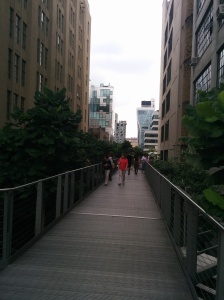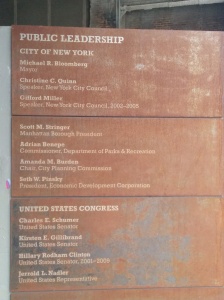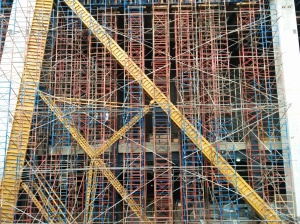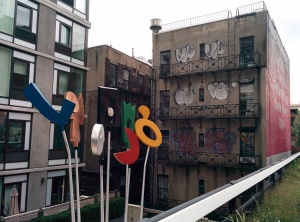The High Line and the Public Good
The High Line is perhaps the most beautiful urban object I know. A former railroad track snaking through Manhattan, it has been repurposed as a garden and architectural haven, above the streets and passing within feet of the surrounding buildings, which are revealed, close up, like canyons to a fighter pilot.
The line started out as private enterprise. I wonder if the development was originally publicly subsidized. It any event the line failed, since trucking made it industrially obsolete. You can still pick out the original ironwork in amongst the grasses. More recently the line was saved by an initiative based on community action, seeded with public money, followed by private money. The funding that has made the High Line incredible is shown by plaques near the middle of the trail to be this mix of public and private influence. I’m in awe of those who had the original vision to see what the line would become.
I first visited the High Line four years ago, then again a few weeks back. What a difference those years have made. So much new private industry has emerged along the sides of the tracks in the streets below – cafes, bars, shops where before there was little. Another example, should we need another, that public works can act as a seed for rapid private investment.
The High Line is also free. It’s a marvel. I read that London is planning a garden bridge. To be great places, cities need inspirational works. We will rarely achieve that from public or private sector alone, but instead a combination without a predictable recipe.
I couldn’t help but extrapolate to pharma.
Medicines sustain people – enabling them to do great things. A society profits enormously if its population is healthy. Effective medicines are a public good, produced by public and private enterprise. Yet we’re not currently producing the medicines we need, and we need to ask why. Perhaps we have become overly reliant on the private sector (which currently funds about 2/3 of all biomedical R&D). Probably no single system will work in producing what we need: every disease is different. The private sector needs the public sector to do what it can’t, and to do that it needs more R&D funds.
But the public sector can do something genuinely radical that it’s not currently doing and which the private sector cannot – embrace an open source approach where all data and ideas are freely shared, anyone may participate and there are no patents. This is the idea behind Open Source Pharma. Such an open, meritocratic arena achieves something quite astonishing: it promotes competition and collaboration at the same time.
The effect of going open source in the development of new therapeutics might simply be to de-risk some avenues of enquiry – to take discovery far enough that the private sector can accommodate the risk. The effect might be to enable genuinely new medicines to be discovered, developed and marketed completely from scratch. And the effect might be to provide a shocking and competing business model, if it’s done right. My money is on all three of these.
But let’s not be lazy and assume that public R&D needs to operate just like private R&D. It would be a serious mistake to spend public money like we’re spending private, pretending that we need to use the same research model. If we’re funding it differently, we can do it differently. So why not play to the strengths of what entrepreneurial public financing can do – and open it up.






Reply